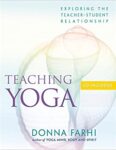Yoga
Why Yoga?
The practice of yoga is what links our teachers together. The inherent philosophy and lifestyle of a yoga practitioner offers a causeway, a shared medium to connect and thrive.
This shared practice sets us apart in the slackline community. Our teaching method includes yogic techniques such as breath awareness, dristhi (focus point), and concentration. This differs from mainstream slacklining in that YogaSlacking is essentially centered on finding stillness on the line, in our body, breath, and mind.
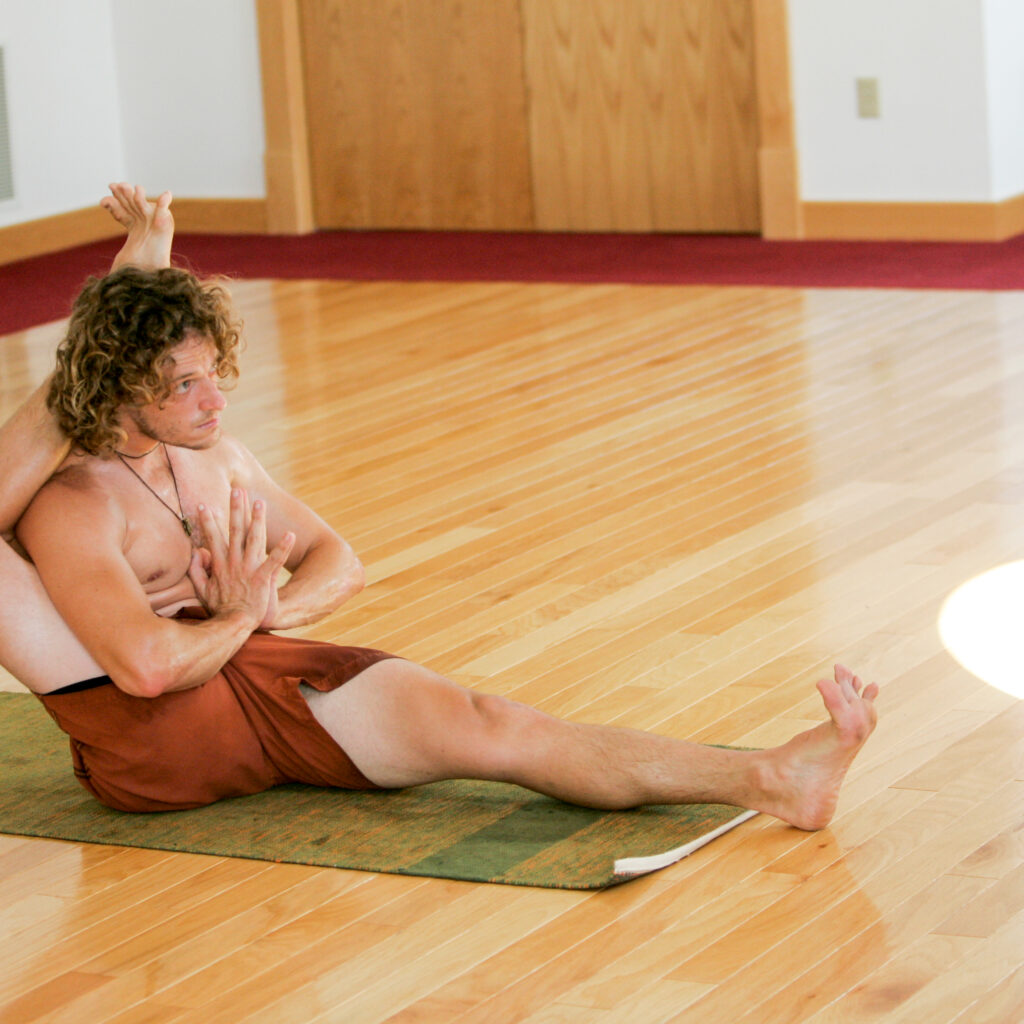
Pre-Classical Yoga
The beginnings of Yoga were developed by the Indus-Sarasvati civilization in Northern India over 5,000 years ago. The word yoga was first mentioned in the oldest of their sacred texts: the Rig Veda. The Vedas are a collection of texts containing songs, mantras and rituals to be used by Brahmans, the Vedic priests. This was a time where the practice of yoga was safeguarded by Brahmans and Rishis and was not directly shared with the general public. At around 500 BCE the Bhagavad Gita was composed.
The Bhagavad Gita is a poem inside the Mahabharata* that takes the form of a philosophical dialogue between Arjuna and Krishna. Arjuna is overcome with self-doubt about the righteousness of the war against his own kith and kin. He is distraught at the thought of having to fight with his friends and family. Krishna (one of the most widely revered and popular of all Hindu deities) took charge and explained the necessity and inevitability of the war. In doing so, he explains to Arjuna the way of yoga and provides detailed instruction on how any individual can achieve union through devotion (Bhakti Yoga), selfless action (Karma Yoga) or search for wisdom (Jnana Yoga).
*The Mahabharata is one of the two major Sanskrit epics of ancient India, the other being the Ramayana.
Classical Yoga
The Eight Limbs of Yoga
- Ahimsa: Nonviolence
- Satya: Truthfulness
- Asteya: Not stealing
- Brahmacharya: Positive use of sexual energies
- Aparigraha: Not being overly attached to things
- Saucha: Cleanliness
- Santosha: Contentment
- Tapas: Self-discipline
- Svadhyaya: Self-study or introspection
- Ishvara Pranidhana: Devotion

3. Asana: comfortable sit
4. Pranayama: control of prana, the subtle life currents in the body
5. Pratyahara: withdrawal of the senses from external objects
6. Dharana: focused concentration
7. Dhyana: meditation
8. Samadhi: experience of oneness
The eightfold path can be simplified and read as a handbook.
First, Patanjali tells us that observing ethics (Yama and Niyama) is the foundation of the practice, without which no spiritual progress can be made. After that he directs us to find a comfortable seat and to control our breath. In this path those are the only four steps we can practice; the next steps will occur spontaneously. Through the control of our breath, we will learn to control our senses to the point in which we will be able to withdraw our senses from any external object. This act will allow us to enter into a state of meditation, or a state of focus without objects. From a state of prolonged meditation we can experience oneness with the universe and therefore complete liberation.
Patanjali’s path is a contemplative path. In summary his instructions were: get your life in order and sit down to search for liberation. A few centuries after Patanjali, the teaching of the Buddha became widely known and meditation continued to be the main form of spiritual practice in India.
post-Classical Yoga
Tantric yogis understood that it was too hard for people to focus on mental practices and to sit down to meditate; the body (considered a temple of the soul) needed to be prepared first. Their system of practices was designed to rejuvenate the body and prolong life. They embraced the physical body as the means to achieve enlightenment and in the process developed their own path: Hatha Yoga.
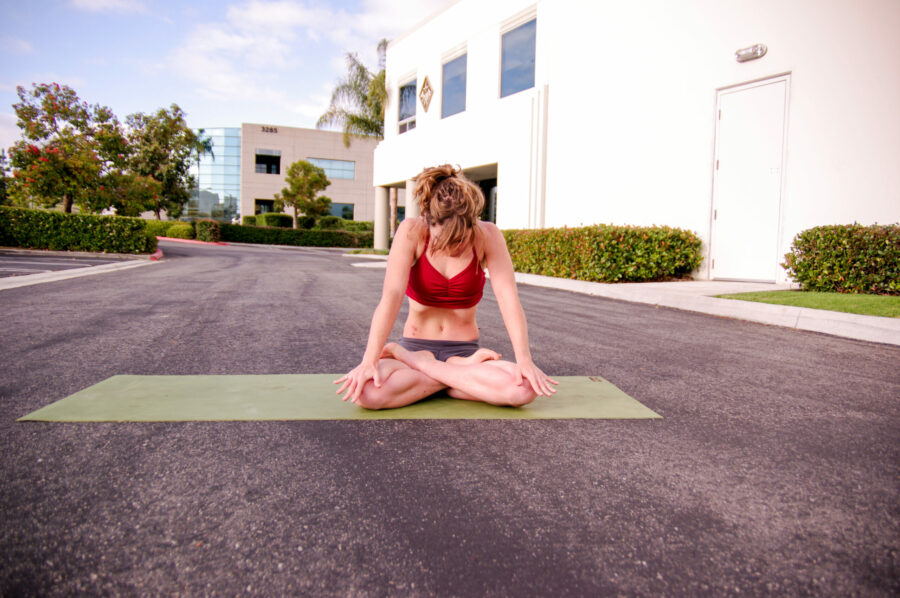
- Neti: rinse debris or mucus from your nasal cavity
- Dhauti: cleaning the upper digestive system by swallowing a strip of wet cloth
- Basti: cleaning of the lower abdomen by a yogic enema
- Kapalbhati: breathing exercise that involves short and strong forceful exhalations
- Trataka: gazing at a single point such as a small object, black dot or candle flame
- Nauli: massage of the digestive organs by a circular movement of the abdominal muscles
3. Pranayama: practice of controlling the breath
4. Mudra: an energetic seal in the body; mainly performed with the hands and fingers
5. Bandha: body locks that are used to contain energy in the body
- Mula Bandha: contraction of the perineum
- Uddiyana Bandha: contraction of the abdomen into the rib cage
- Jalandhara Bandha: tucking the chin close to the chest
- Maha Bandha: combining all three of the above bandhas
Through these practices one’s consciousness can be raised without having to directly confront the mind during meditation. Hatha Yoga is considered the preliminary practice of Tantra, Raja, Kundalini and Kriya Yoga.
Hatha Yoga is the means and Raja Yoga is the ultimate goal: Samadhi.
Modern Yoga
T. Krishnamacharya
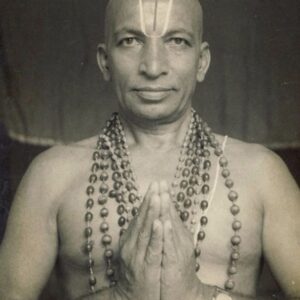
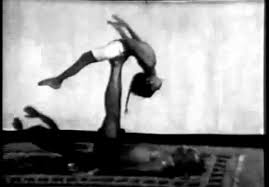
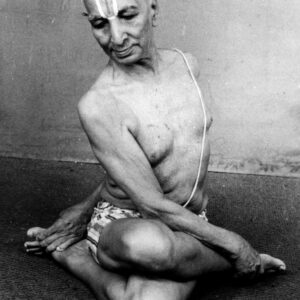
Krishnamacharya considered Yoga to be India’s greatest gift to the world. His yoga instruction reflected his understanding that yoga could be both a spiritual practice and a mode of physical healing. He approached every student as absolutely unique. Believing that the most important aspect of teaching yoga was that the student be taught according to his or her individual capacity at any given time.
Krishnamacharya's Students
Through his students and the styles they developed, Krishnamacharya’s teachings influenced almost every modern hatha yoga tradition.
Indra wrote, “Forever Young, Forever Healthy” and “Yoga For Americans: A Complete Six Weeks’ Course For Home Practice> ”.
You can read more about her in “The Goddess Pose: The Audacious Life of Indra Devi, the Woman Who Helped Bring Yoga to the West“ by Michelle Goldberg.
Pattabhi Jois*: developed and popularized the vinyasa style of yoga referred to as Ashtanga Vinyasa Yoga. Ashtanga Vinyasa Yoga is a style of yoga characterized by a set practice that begins with five repetitions of Surya Namaskara (Sun Salutation) A and five repetitions of Sun Salutation B, followed by a standing sequence, one of six series, followed by what is called the closing sequence. The practice is traditionally taught in ‘Mysore style’, as reference to the place of origin of the practice. Students memorize a sequence and practice in the same room as others without being led by the teacher. The role of the teacher is to guide as well as provide adjustments.
The Ashtanga Vinyasa Yoga system gave rise to Power Yoga, Flow Yoga and other Vinyasa / Flow base classes.
*We are aware of the sexual misconduct accusations related to Pattabhi Jois. While we do not condoned his behavior, we decided to list him here, as we cannot deny the influence of Ashtanga Vinyasa Yoga on the origin of our practice and other practice styles.
T.K.V. Desikachar: son of Krishnamacharya. Explores the use of contemporary approaches to Hatha Yoga for therapeutic potential. His practice was described by the name of the Viniyoga or application of Yoga. Desikachar describes his method not as a style of yoga, but an approach to utilizing yogic tools.
Slackline Yoga
As Krishnamacharya said, the path of yoga means different things for different people, and each person ought to be taught in a manner that they clearly understand.
Hatha Yoga now has many different schools or styles, all emphasizing the many different aspects of the practice. In general, when most people speak of Yoga, they are mostly referring to a form of Hatha Yoga, which derived from Tantra Yoga in an effort to reach Raja Yoga.
Slackline Yoga is no different. The most different aspect of our style of hatha yoga is that – instead of using a yoga mat, a meditation cushion or a rug – our practice happens while balancing on a thin piece of webbing.
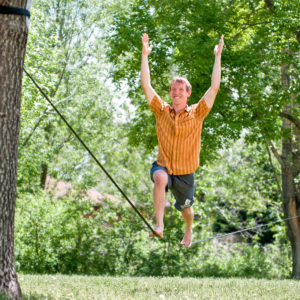
References
- Buck, William (1973). Mahabharata. University of California Press.
- Easwaran, Eknath (1987). The Upanishads. Tomales: Nilgiri Press.
- Feuerstein, Georg, PhD. (1998). The Yoga Tradition: Its History, Literature, Philosophy and Practice. Hohm Press.
- Jois, Shri K. Pattabhi. (2002). Yoga Mala: The seminal treatise and guide from the living master of Ashtanga Yoga. North Point Press.
- Muktibodhananda, Swami. (1998). Hatha Yoga Pradipika. Yoga Publications Trust.
- Prabhavananda, Swami and Christopher Isherwood. (2001). How to Know God: The Yoga Aphorisms of Patanjali. Hollywood: Vedanta Press.
- Prabhavananda, Swami and Christopher Isherwood (2001). The Song of God: Bhagavad Gita. Hollywood: Vedanta Press. (With an introduction by Aldous Huxley)
- Satchidananda, Swami. (2009). The Yoga Sutras of Patanjali. Integral Yoga Publications.




